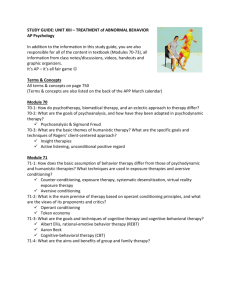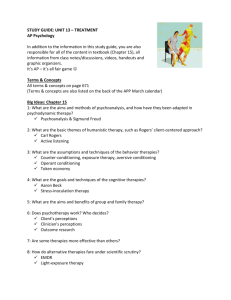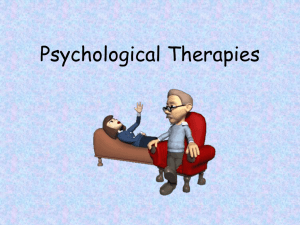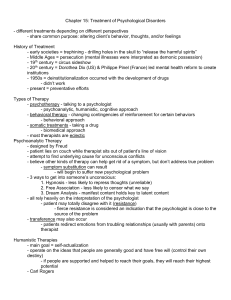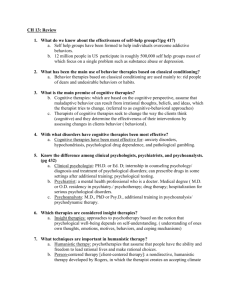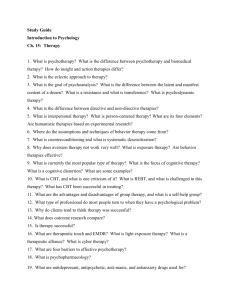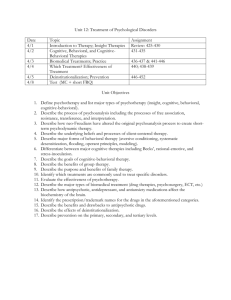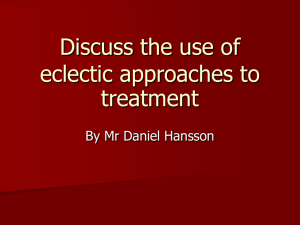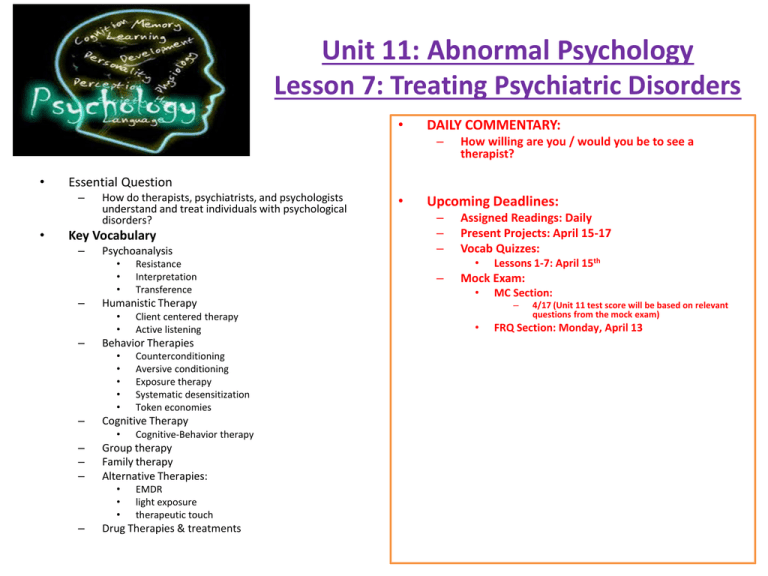
Unit 11: Abnormal Psychology
Lesson 7: Treating Psychiatric Disorders
•
DAILY COMMENTARY:
–
•
Essential Question
–
•
How willing are you / would you be to see a
therapist?
How do therapists, psychiatrists, and psychologists
understand and treat individuals with psychological
disorders?
Key Vocabulary
–
Psychoanalysis
•
•
•
–
Humanistic Therapy
•
•
–
Resistance
Interpretation
Transference
Client centered therapy
Active listening
Behavior Therapies
•
•
•
•
•
Counterconditioning
Aversive conditioning
Exposure therapy
Systematic desensitization
Token economies
–
Cognitive Therapy
–
–
–
Group therapy
Family therapy
Alternative Therapies:
•
•
•
•
–
Cognitive-Behavior therapy
EMDR
light exposure
therapeutic touch
Drug Therapies & treatments
•
Upcoming Deadlines:
–
–
–
Assigned Readings: Daily
Present Projects: April 15-17
Vocab Quizzes:
•
–
Lessons 1-7: April 15th
Mock Exam:
•
MC Section:
–
•
4/17 (Unit 11 test score will be based on relevant
questions from the mock exam)
FRQ Section: Monday, April 13
Take notes from PsychSim 5
• Therapies
– Mystery Client Module
– Mystery Therapist
• Then move on – check out some of the
disorder modules
• Then work on your Presentations – Due
Monday
THERAPEUTIC TREATMENTS
FOR PSYCHOLOGICAL
DISORDERS
By: Christopher K. Nixon
A Historical Perspective
• Treatment options for people with
mental illness have improved
tremendously over time.
• Beginning in the 1500s, asylums were
created to care for the mentally ill.
• Cells were dark dungeons with no
provisions for heat in the winter.
A Historical Perspective
• Patients’ hands and feet were
chained and patients slept on straw
rather than beds.
• As they were chained to the walls,
they were forced to sit in their own
urine and feces.
Asylum Reform in Europe
• In 1792, Philippe Pinel was placed in charge of an
asylum in Paris – an asylum bearing the
aforementioned conditions.
• Pinel’s philosophy was that the mentally ill should
be treated with consideration and kindness.
• Pinel removed the shackles, allowed patients to go
outside on hospital grounds, and gave them beds to
sleep on.
Asylum Reform in the U.S.
• In the United States, the mentally ill were
traditionally either institutionalized in the manner
just described, kept in jails and poor houses, or
just left alone to wonder the countryside.
• Yet, through the efforts of Dorothea Dix during
the 19th century, a network of state-funded
mental hospitals began to emerge.
• Many of these hospitals were extremely large
facilities.
The Emergence of Psychological
Therapy
• Sigmund Freud is widely credited with
launching modern psychotherapy.
– Freud was inspired by his colleague Josef
Breuer’s work with a young woman
referred to as “Anna O.”
– Anna O. exhibited many physical maladies
– headaches, coughing, loss of feeling and
movement in her right arm.
– Breuer discovered that Anna’s symptoms
began to clear up when he encouraged
her to talk about emotionally charged
experiences from her past.
The Emergence of Psychological
Therapy
• Freud applied Breuer’s treatment to other patients
and found similar success…
• This led to the development of a systematic
treatment procedure focused on uncovering bottled
up emotions, unconscious conflict and the like… He
called this therapy “Psychoanalysis”
• This, in may ways, was the beginning of
Psychotherapy.
The Nature and Purpose of Therapy
• “Therapy”, from the Latin term therapīa literally
means “curing, healing”.
• Psychotherapies aim to provide people with an
explanation for their problems, offer hope, and
engage the client in a therapeutic alliance with their
therapist.
• Therapies are often used to alleviate issues such as:
Drug and alcohol dependence, bipolar disorder,
major depression, phobic disorder, posttraumatic
stress, generalized anxiety disorder, and panic
disorder.
Therapies
Psychotherapy involves an emotionally
charged, confiding interaction between a
trained therapist and a mental patient.
Biomedical therapy uses drugs or other
procedures that act on the patient’s nervous
system, curing him or her of psychological
disorders.
An eclectic approach uses various forms of
healing techniques depending upon the client’s
unique problems.
11
Therapies we will analyze
•
•
•
•
•
Insight Therapies
Behavioral Therapies
Cognitive Therapies
Group Therapies
Biomedical Therapies
Psychological Therapies
Most therapeutic methods are based in a
particular approach to understanding human
Psychology
1.
2.
3.
4.
Psychoanalytical theory (Freud, Adler, Jung)
Humanistic theory (Maslow, Rogers)
Behavioral theory (Pavlov, Skinner)
Cognitive theory (Bandura)
13
Insight Therapies
• Insight therapies are “a variety of individual
psychotherapies designed to give people a
better awareness and understanding of their
feelings, motivations, and actions in the hope
that this will help them adjust.”
•
•
•
•
Psychoanalysis
Client-Centered Therapy
Therapies Inspired by Positive Psychology
Gestalt Therapy
Psychoanalysis
The first formal psychotherapy to emerge was
psychoanalysis, developed by Sigmund Freud.
Edmund Engleman
Sigmund Freud's famous couch
15
The Emergence of Psychological
Therapy
• Sigmund Freud is widely credited with
launching modern psychotherapy.
– Freud was inspired by his colleague Josef
Breuer’s work with a young woman
referred to as “Anna O.”
– Anna O. exhibited many physical maladies
– headaches, coughing, loss of feeling and
movement in her right arm.
– Breuer discovered that Anna’s symptoms
began to clear up when he encouraged
her to talk about emotionally charged
experiences from her past.
Psychoanalytic Techniques
• Free association – clients spontaneously express
their thoughts and feelings exactly as they occur,
with as little censorship as possible. Gradually, all
of the repressed material begins to flow out into
the open.
• Dream analysis – the therapist interprets the
symbolic meaning of the client’s dreams. Freud
saw dreams as the “royal road to the
unconscious”.
Psychoanalytic Techniques
• Interpretation – the therapist’s attempts to
explain the inner significance of the client’s
thoughts, feelings, memories, and behaviors.
• Transference – when clients unconsciously
start relating to their therapist in ways that
mimic critical relationships in their lives…
Arguing with the therapist as you would with
an abusive parent, for example.
Psychoanalysis: Criticisms
1. Psychoanalysis is hard to refute because it
cannot be proven or disproven.
2. Psychoanalysis takes a long time and is very
expensive.
19
Client/Person-Centered Therapy
• Using a Humanistic Perspective, Carl Rogers
devised client-centered therapy in the 1940s and
1950s.
• CCT is “an insight therapy that emphasizes
providing a supportive emotional climate for
clients, who play a major role in determining the
pace and direction of their therapy.
Client/Person-Centered Therapy
• This therapy is usually for those who seek to “find
themselves” or “get in touch with their real feelings.”
• The therapeutic climate tends to be one of:
• Genuineness – honest and spontaneous
communication between therapist and client
• Unconditional positive regard – nonjudgmental
acceptance of the client as a person
• Empathy – the therapist seeks to understand the
world from the client’s point of view
Humanistic Therapy
The therapist engages in active listening and
echoes, restates, and clarifies the patient’s
thinking, acknowledging expressed feelings.
Michael Rougier/ Life Magazine © Time Warner, Inc.
22
Therapies Inspired by Positive
Psychology
• Positive Psychology was founded by Martin
Seligman.
– Positive Psychology “uses theory and research to
better understand the positive, adaptive, creative,
and fulfilling aspects of human existence.”
– The emphasis isn’t on weakness and pathology as
with most other psychotherapies, rather; the focus
is on contentment, well-being, human strengths,
and positive emotions.
Gestalt Therapy
• Gestalt therapy is largely an outgrowth of the work
of Frederick Perls
• The therapy is designed to help people become more
genuine or “real” in their day-to-day interactions.
• The term Gestalt means “whole”, as such, the
therapist’s role is to “fill in the holes in the
personality to make the person whole and complete
again.”
• For example, the therapist might tell a person to
“own their feelings” through talking in an active,
rather than passive way.
Behavior Therapy
Therapy that applies learning principles to the
elimination of unwanted behaviors.
To treat phobias or sexual disorders, behavior therapists do not delve deeply
below the surface looking for inner causes.
25
Behavioral Therapies
• Behavior therapies differ from the insight therapies
– They make no attempt to help clients achieve insights
about themselves, but seek simply to change the
behavior.
– Maladaptive behaviors such as compulsive gambling,
alcohol and drug abuse, fear responses to external
stimuli (phobias), and personal care maintenance are
often the focus here.
• Classical Conditioning
• Operant Conditioning
Classical vs. Operant Conditioning
Therapies
• Classical Conditioning therapies seek to remove
the undesirable behavior by reconditioning the
client to produce desired behaviors.
• Therapies based on operant conditioning
attempt to alter the consequences of the
client’s behavior.
– The therapist uses positive reinforcement, negative
reinforcement, punishment, and extinction to
modify client behavior… Reward the desired, punish
the undesired, for example…
Classical Conditioning Techniques
Counterconditioning is a procedure that
conditions new responses to stimuli that trigger
unwanted behaviors.
It is based on classical conditioning and includes exposure therapy and aversive
conditioning.
28
Exposure Therapy
The Far Side © 1986 FARWORKS. Reprinted with Permission. All Rights Reserved.
Expose patients to
things they fear and
avoid. Through
repeated exposures,
anxiety lessens
because they
habituate to the
things feared.
29
Systematic Desensitization
• A classical conditioning exposure therapy
that associates a pleasant, relaxed state
with gradually increasing anxietytriggering stimuli commonly used to treat
phobias.
Aversive Conditioning
A type of
counterconditioning
that associates an
unpleasant state with
an unwanted behavior.
With this technique,
temporary
conditioned aversion
to alcohol has been
reported.
31
Operant Conditioning
Operant conditioning procedures enable
therapists to use behavior modification, in
which desired behaviors are rewarded and
undesired behaviors are either unrewarded or
punished.
A number of withdrawn, uncommunicative 3-year-old autistic children have
been successfully trained by giving and withdrawing reinforcements for desired
and undesired behaviors.
32
Token Economy
• Based on Operant Conditioning, a system wherein
subjects are given tokens for desirable behaviors and
are taken away for various undesirable behaviors.
• These tokens can later be exchanged by the client for a
wide variety of rewards and priveledges.
• Token economies have been especially useful in mental
hospitals where desirable behaviors might include
aiding in self-care, making one’s own bed, and
interacting well with others.
Behavioral Contract
• A written agree that explicitly states the
consequences of certain acts…
• Such contracts are useful in resolving
interpersonal conflict
• Consider a marriage wherein the wife is fed up
with the husband always leaving his socks
everywhere)
Cognitive Therapy
Teaches people adaptive ways of thinking and
acting based on the assumption that thoughts
intervene between events and our emotional
reactions.
35
Cognition
• Cognitions are mental processes (memory,
interpretation of experience, beliefs, ideas,
thoughts, perception.)
• Cognitive Psychotherapy focuses mostly on
interpretations, beliefs and perception.
• Consider the cognitive characteristics of a
depression-prone person…
Cognitive Therapy for Depression
• Aaron Beck (1979) suggests that depressed
patients believe that they can never be happy
(thinking) and thus associate minor failings (e.g.
failing a test [event]) in life as major causes for
their depression.
Enter Becks’s COGNITIVE BEHAIVORAL THERAPY
Beck believes that cognitions such as “I can never be happy” need to change in
order for depressed patients to recover. This change is brought about by gently
questioning patients.
37
Cognitive Therapy for Depression
Rabin et al., (1986) trained depressed
patients to record positive events each day,
and relate how they contributed to these
events. Compared to other depressed
patients, trained patients showed lower
depression scores.
38
Stress-Inoculation Therapy
• “A type of cognitive therapy that trains clients to cope
with stressful situations by learning a more useful pattern
of self-talk.”
• The client is taught to replace negative, anxietyprovoking inner dialogue with positive, affirmative,
“coping” dialogue.
• The Positive self talks becomes a kind of vaccine against
stress-induced anxiety.
• Instead of, saying “This class is too difficult, I will fail…”,
say “I studied hard, I am ready to give my best.”
Rational-Emotive Therapy
• Developed by Albert Ellis, RET is “a directive
cognitive therapy based on the idea that clients’
psychological distress is caused by irrational and selfdefeating beliefs, and that the therapist’s job is to
challenge such dysfunctional beliefs.”
• The desired outcome is that the client will see these
beliefs for what they are and change them.
• Irrational beliefs are often extreme
generalizations.
Beck’s Cognitive Therapy
• Developed by Aaron Beck, this therapy “depends on
identifying and changing inappropriately negative
and self-critical patterns of thought.”
• It differs from Rational-Emotive Therapy in that the
client is encouraged to come up with challenges to
their own irrational beliefs, rather than the therapist
doing so…
Cognitive-Behavior Therapy
Cognitive therapists often combine the reversal
of self-defeated thinking with efforts to modify
behavior.
Cognitive-behavior therapy aims to alter the way people act (behavior therapy)
and alter the way they think (cognitive therapy).
42
Group Therapy
• Family Therapy
• Couples Therapy
• Self-Help Groups
Group Therapy
• Group therapy is “a type of psychotherapy in
which clients meet regularly to interact and
help one another achieve insight into their
feelings and behavior.”
• Group therapy can also help to identify
problems that a person has when interacting
with other people (hostility, aggressiveness,
hyper-anxious…)
Group Therapy
Group therapy normally consists of 6-9 people attending a 90-minute session that
can help more people and costs less. Clients benefit from knowing others have
similar problems.
© Mary Kate Denny/ PhotoEdit, Inc.
45
Family Therapy
• Family therapy is “a form of group therapy that sees
the family as at least partly responsible for the
individual’s problems and that seeks to challenge all
family members’ behaviors to the benefit of the
family unit as well as the troubled individuals.”
• The primary goals are improving family
communication, encouraging increased empathy
between family members, getting each other to
share responsibility, and reducing conflict.
Couple Therapy
• Couple therapy is a form of therapy is intended to
help troubled partners improve their problems of
communication and interaction.
• One technique is called empathy training,
wherein each member is taught to listen to and
understand their partner’s feelings before
responding to them.
Self-Help Groups
• Because an estimated 40 million Americans
suffer some kind of psychological problem
(Narrow et al., 2001), and because the cost of
individual treatment can be so high, more
people who are faced with crises are turning to
low cost self-help groups.
• Most group members express strong support
for their groups.
The Relative Effectiveness of Different
Therapies
Which psychotherapy would be most effective
for treating a particular problem?
Disorder
Therapy
Depression
Behavior, Cognition, Interpersonal
Anxiety
Cognition, Exposure, Stress Inoculation
Bulimia
Cognitive-behavior
Phobia
Behavior
Bed Wetting
Behavior Modification
49
Evaluating Alternative Therapies
Lilienfeld (1998) suggests comparing scientific
therapies against popular therapies through
electronic means. The results of such a search
are below:
50
Eye Movement Desensitization and
Reprocessing (EMDR)
In EMDR therapy, the therapist attempts to
unlock and reprocess previous frozen traumatic
memories by waving a finger in front of the
eyes of the client.
EMDR has not held up under scientific testing.
51
Light Exposure Therapy
Courtesy of Christine Brune
Seasonal Affective
Disorder (SAD), a
form of depression,
has been effectively
treated by light
exposure therapy. This
form of therapy has
been scientifically
validated.
52
Biomedical Therapy
• Biomedical Therapies are “physiological
interventions intended to reduce symptoms
associated with psychological disorders.”
• Drug Therapy
• Electroconvulsive Therapy
• Psychosurgery
Drug Therapy
• Psychopharmacology is “the treatment of mental
disorders with medication.”
• This form of treatment is commonly referred to as
drug therapy.
• The four main categories of theraputic drugs for
psychological problems are:
• Anti-anxiety drugs
• Antipsychotic drugs
• Antidepressant drugs
• Mood-Stabilizing drugs
Drug Therapy
• Antianxiety drugs are used to relieve tension, apprehension, and
nervousness.
• Valium, Xanax and other drugs in the benzodiazepine family are
often called tranquilizers.
• GABA
• Antipsychotic Drugs are used to gradually reduce psychotic
symptoms, including hyperactivity, mental confusion,
hallucinations, and delusions.
• Such drugs appear to decrease activity at certain subtypes of
dopamine synapses.
Antianxiety Drugs
Antianxiety drugs (Xanax and Ativan) depress the
central nervous system and reduce anxiety and tension
by elevating the levels of the Gamma-aminobutyric acid
(GABA) neurotransmitter.
57
Atypical Antipsychotic
Clozapine (Clozaril) blocks receptors for
dopamine and serotonin to remove the negative
symptoms of schizophrenia.
58
Mood-Stabilizing Medications
Lithium Carbonate, a common salt, has been used
to stabilize manic episodes in bipolar disorders. It
moderates the levels of norepinephrine and
glutamate neurotransmitters.
59
Drug Therapy
• Antidepressant Drugs gradually elevate mood and
help bring people out of a depression.
• The newest class of antidepressant drugs are
known as selective serotonin reuptake inhibitors.
• Mood Stabilizers are drugs used to control mood
swings in patients with bipolar mood disorder.
• Lithium is common mood stabilizer.
• The neurotransmitter that these drugs affect is
presently unknown.
Antidepressant Drugs
Antidepressant drugs like Prozac, Zoloft, and Paxil are
Selective Serotonin Reuptake Inhibitors (SSRIs) that
improve the mood by elevating levels of serotonin by
inhibiting reuptake.
61
Electroconvulsive Therapy
• Electroconvulsive Therapy is a biomedical
treatment in which electric shock is used to
produce a cortical seizure accompanied by
convulsions.
• In recent decades, this treatment has primarily
been recommended for the treatment of
depression.
Psychosurgery
• Psychosurgery is a form of brain surgery
performed to change a person’s behavior and
emotional state.
• This form of biomedical therapy is rarely used
today.


